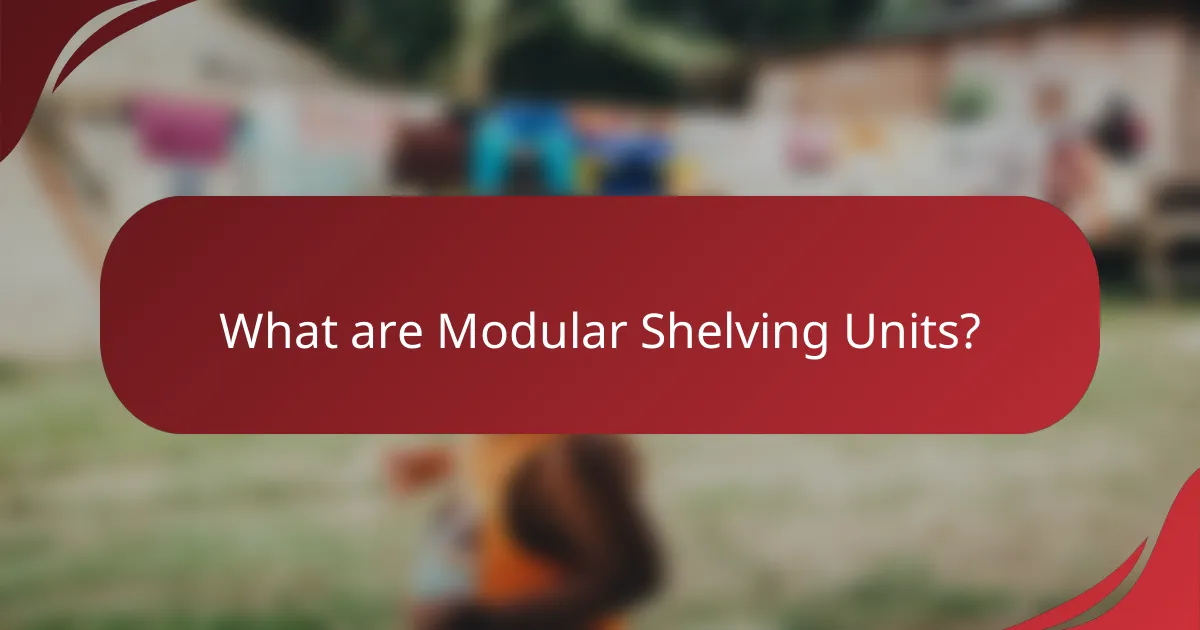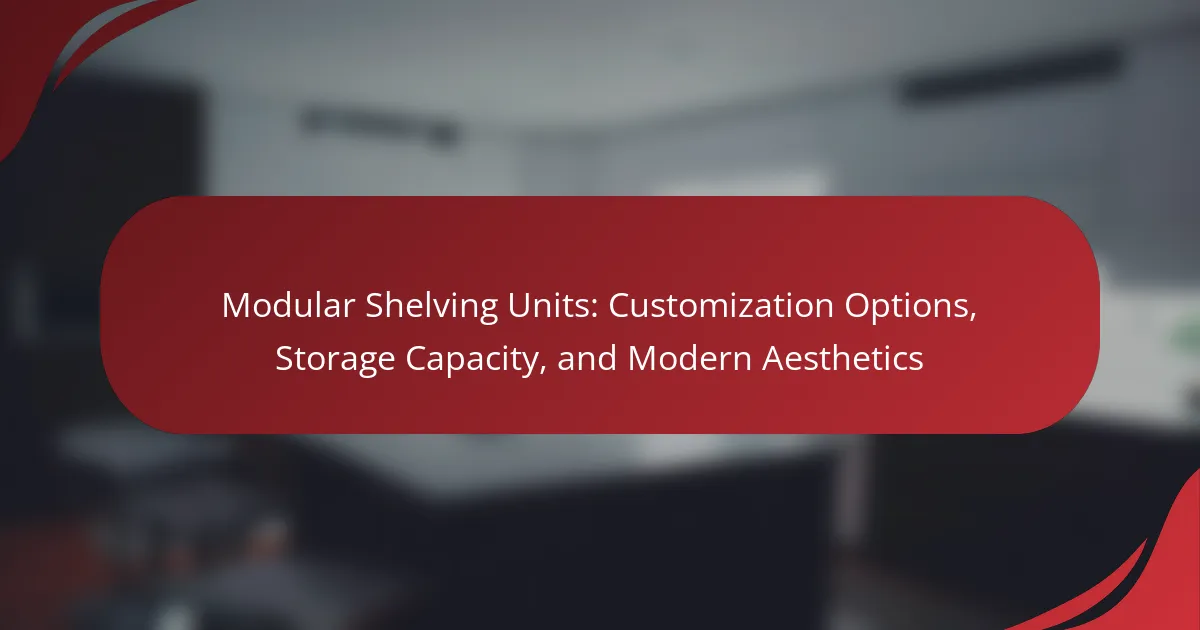Modular shelving units are customizable storage systems designed to adapt to various spaces and needs. They consist of individual components made from materials such as wood, metal, or plastic, allowing users to arrange them in multiple configurations. These units support a range of items, including books and decorative objects, while promoting both functionality and aesthetics. Key features include adjustable shelves, customizable colors and finishes, and accessories that enhance their usability. The versatility of modular shelving units makes them suitable for both residential and commercial environments, effectively maximizing storage capacity and improving organization.

What are Modular Shelving Units?
Modular shelving units are versatile storage systems that can be customized and reconfigured. They consist of individual components that can be arranged in various ways. This allows users to adapt the shelving to different spaces and needs. Modular shelving is often made from materials like wood, metal, or plastic. These units can support a range of items, from books to decorative objects. Their design promotes both functionality and aesthetics. Many modular shelving systems offer adjustable shelves for added flexibility. This adaptability makes them popular in both residential and commercial settings.
How do Modular Shelving Units function?
Modular shelving units function by allowing users to customize their configuration for various storage needs. These units consist of separate components that can be rearranged or added to. Users can select different sizes, shapes, and materials for their shelves. This flexibility accommodates diverse spaces and storage requirements. Modular systems often include adjustable shelves for height variation. They can be easily assembled or disassembled without specialized tools. Many designs also allow for wall mounting or freestanding options. This adaptability makes modular shelving units suitable for both residential and commercial environments.
What are the essential components of Modular Shelving Units?
Modular shelving units consist of several essential components. These include shelves, brackets, and connectors. Shelves provide the main storage space. Brackets support the shelves and attach them to the wall or frame. Connectors link multiple shelving units together. Additionally, side panels may offer stability and enhance aesthetics. Adjustable height options allow for customization based on user needs. Each component plays a crucial role in the functionality and versatility of modular shelving systems.
How do these components contribute to functionality?
Modular shelving units enhance functionality through their customizable design, storage capacity, and modern aesthetics. Customization allows users to adapt the shelving to fit various spaces and needs. This adaptability ensures optimal use of available space. Increased storage capacity enables organization of diverse items, making access easier. Modern aesthetics contribute to a visually appealing environment, promoting a positive atmosphere. The combination of these components ensures that modular shelving units meet both practical and aesthetic requirements effectively.
What are the key benefits of using Modular Shelving Units?
Modular shelving units offer flexibility, efficient use of space, and aesthetic appeal. Their design allows for easy reconfiguration to fit different spaces and needs. This adaptability makes them suitable for various environments, including homes and offices. Additionally, they maximize storage capacity by utilizing vertical space effectively. Many modular shelving units come in various styles and finishes, enhancing the overall decor. Their modular nature also promotes organization by allowing users to customize layouts. Furthermore, they are often easy to assemble and disassemble, facilitating relocation. These benefits collectively make modular shelving units a practical choice for modern storage solutions.
How do Modular Shelving Units enhance organization?
Modular shelving units enhance organization by providing flexible storage solutions. They can be customized to fit various spaces and needs. Different configurations allow for optimal use of vertical space. Adjustable shelves accommodate items of varying sizes. This adaptability helps reduce clutter and improves accessibility. Additionally, modular units can be rearranged as storage needs change. Their design promotes a tidy and visually appealing environment. Research indicates that organized spaces can improve productivity and reduce stress.
What are the cost-saving advantages of Modular Shelving Units?
Modular shelving units provide significant cost-saving advantages through their flexibility and efficiency. They can be reconfigured to meet changing storage needs, reducing the need for additional furniture purchases. This adaptability minimizes long-term expenses associated with storage solutions. Additionally, modular units often use less material than traditional shelving, lowering production costs. Their design allows for easy assembly and disassembly, cutting down on labor costs during installation. Studies indicate that businesses using modular shelving report up to 30% savings in storage-related expenses. Overall, modular shelving units are a financially smart choice for both residential and commercial spaces.

What customization options are available for Modular Shelving Units?
Modular shelving units offer various customization options. Customers can choose from different materials such as wood, metal, or glass. They can select specific colors and finishes to match their decor. Adjustable shelf heights allow for varying storage needs. Some units offer customizable configurations for unique spaces. Accessories like hooks, bins, and lighting can enhance functionality. Additionally, modular systems can be expanded or reconfigured as needs change. These options provide flexibility and personalization for users.
How can users personalize their Modular Shelving Units?
Users can personalize their Modular Shelving Units through various customization options. They can select different materials such as wood, metal, or plastic for a tailored look. Users can also choose from a variety of colors and finishes to match their interior design. Adjustable shelf heights allow for flexibility in storage. Users can incorporate additional features like drawers or cabinets for functionality. Accessories such as lighting or decorative elements can enhance the aesthetic appeal. Many manufacturers offer modular components that can be rearranged to fit specific spaces. This level of customization ensures that each shelving unit meets individual needs and preferences.
What materials can be selected for Modular Shelving Units?
Modular shelving units can be made from various materials. Common options include wood, metal, and plastic. Wood provides a classic look and durability. Metal offers a modern aesthetic and strength. Plastic is lightweight and often more affordable. Each material has unique benefits and can suit different design preferences. For example, plywood is often used for its versatility. Steel is favored for industrial styles. These materials allow for customization in design and function.
What design styles are available for customization?
Modular shelving units are available in various design styles for customization. Common styles include modern, minimalist, industrial, rustic, and Scandinavian. Each style offers distinct visual characteristics and functionality. Modern designs feature sleek lines and a contemporary aesthetic. Minimalist styles emphasize simplicity and uncluttered spaces. Industrial designs incorporate raw materials like metal and wood for a rugged look. Rustic styles bring warmth and charm with natural finishes. Scandinavian designs focus on light colors and functional forms. These styles cater to diverse preferences and interior design themes.
What modular configurations are possible?
Modular shelving units can be configured in various arrangements. Common configurations include wall-mounted, freestanding, and corner units. Wall-mounted units save floor space and can be customized in height and width. Freestanding units offer flexibility in placement and can be rearranged easily. Corner units maximize unused space and create a seamless look. Additionally, configurations can include adjustable shelves, integrated lighting, and various materials for aesthetic appeal. These options allow users to tailor their shelving to fit specific needs and spaces.
How do different configurations impact storage capacity?
Different configurations directly affect storage capacity by altering the arrangement and number of shelves. For example, vertical configurations maximize height, allowing for more shelves and increased storage. Horizontal configurations may provide wider shelf space but limit vertical storage. The number of sections in a modular unit can also impact capacity; more sections typically allow for more items to be stored. Additionally, the depth of the shelves influences how much can be stored. Deeper shelves accommodate larger items but may limit the number of items per shelf. Configurations that include adjustable shelves provide flexibility, allowing users to customize space according to their needs. Therefore, the choice of configuration is crucial in determining overall storage capacity.
What are the advantages of adjustable shelving in Modular Units?
Adjustable shelving in modular units offers flexibility in storage. This allows users to modify shelf heights according to their needs. It accommodates items of various sizes efficiently. Users can easily rearrange the shelves as storage requirements change. This adaptability enhances the functionality of the space. Adjustable shelving also promotes better organization by allowing for optimal use of vertical space. It can lead to improved accessibility of stored items. Overall, it maximizes storage efficiency and user convenience in modular units.

How do Modular Shelving Units address storage capacity needs?
Modular shelving units effectively address storage capacity needs by offering customizable configurations. These units can be adjusted in height, width, and depth to fit various spaces. Users can add or remove shelves based on their specific storage requirements. This adaptability allows for efficient use of vertical space, maximizing storage potential in limited areas. Additionally, modular systems can accommodate different types of items, from books to decorative objects. According to a study by the American Institute of Architects, flexible storage solutions improve organization and accessibility in residential and commercial settings. This versatility makes modular shelving units an optimal choice for diverse storage challenges.
What factors influence the storage capacity of Modular Shelving Units?
The storage capacity of Modular Shelving Units is influenced by several factors. First, the dimensions of the unit determine how much space is available for storage. Larger units can hold more items. Second, the design and configuration of the shelves affect capacity. Adjustable shelves can accommodate various item sizes. Third, the material used impacts strength and durability. Stronger materials can support heavier loads. Fourth, the weight distribution of items placed on the shelves is crucial. Uneven weight can lead to instability. Lastly, the intended use of the shelving unit will influence its design and capacity requirements. For example, units designed for books may differ from those for decorative items.
How does the size and design of a unit affect its capacity?
The size and design of a modular shelving unit directly influence its storage capacity. Larger units typically provide more shelf space, allowing for greater storage of items. Design factors, such as shelf height and width, also play a crucial role. For instance, deeper shelves can accommodate bulkier items. Additionally, adjustable shelving allows for customization based on the size of stored items. Research indicates that units designed with vertical space utilization in mind maximize storage efficiency. A study by the American Institute of Architects highlights that thoughtful design can increase capacity by up to 30%. Thus, both size and design are critical in determining the overall capacity of shelving units.
What are the weight limits for different Modular Shelving Units?
Weight limits for modular shelving units vary by design and manufacturer. Typically, standard modular shelving units hold between 50 to 200 pounds per shelf. Heavy-duty options can support up to 500 pounds per shelf. For example, industrial-grade shelves often feature reinforced materials for increased weight capacity. Always consult the manufacturer’s specifications for precise limits. This ensures safe usage and prevents overloading.
What are the best practices for maximizing storage in Modular Shelving Units?
To maximize storage in modular shelving units, utilize vertical space effectively. Arrange shelves at varying heights to accommodate items of different sizes. Incorporate bins or baskets for smaller items to prevent clutter. Use clear containers for visibility and easy access to contents. Group similar items together to streamline organization. Install hooks or hanging elements for added storage options. Consider adjustable shelves to adapt to changing storage needs. Regularly declutter and reassess stored items to maintain optimal use of space. These practices enhance storage capacity and improve overall functionality.
How can organization techniques improve storage efficiency?
Organization techniques can significantly improve storage efficiency by maximizing available space and reducing clutter. Effective categorization allows for easy access to items, minimizing time spent searching. Utilizing vertical space through shelving techniques increases storage capacity without requiring additional floor space. Implementing clear labeling systems enhances item identification, streamlining retrieval processes. Moreover, modular shelving units can be customized to fit specific needs, optimizing the arrangement of items. Research indicates that organized spaces can increase productivity by up to 20%, supporting the benefits of these techniques.
What common mistakes should be avoided when using Modular Shelving Units?
Common mistakes to avoid when using modular shelving units include improper weight distribution. Overloading shelves can lead to structural failure. Another mistake is neglecting to measure the space accurately. This can result in poor fitting and wasted space. Failing to secure units to the wall poses safety risks, especially in homes with children. Additionally, overlooking the importance of accessibility can make items difficult to reach. Not considering the unit’s material can lead to durability issues. Lastly, disregarding aesthetic alignment with the room’s style can create visual dissonance. These errors can undermine the functionality and appeal of modular shelving units.

How do Modular Shelving Units contribute to modern aesthetics?
Modular shelving units enhance modern aesthetics through their versatile design and functionality. They offer a customizable look that can adapt to various interior styles. This adaptability allows for seamless integration into minimalist, industrial, or contemporary spaces. The use of clean lines and geometric shapes in modular units contributes to a sleek appearance. Additionally, they can be arranged in various configurations, promoting a sense of openness. Materials like metal, wood, and glass used in these units add to their modern appeal. Research indicates that well-designed shelving can improve spatial perception and organization in living areas. Thus, modular shelving units serve as both decorative and practical elements in modern interiors.
What design trends are associated with Modular Shelving Units?
Modular shelving units are characterized by several design trends. These trends include minimalism, which emphasizes clean lines and simplicity. Another trend is versatility, allowing units to adapt to various spaces and functions. Sustainable materials are increasingly used, reflecting eco-conscious design choices. Customization options are popular, enabling users to tailor configurations to personal needs. Open shelving is favored for creating an airy feel and showcasing decor. Finally, mixed materials, such as wood and metal, are utilized to enhance aesthetic appeal. These trends collectively contribute to the modern aesthetics of modular shelving units.
How do color and finish impact the aesthetic appeal?
Color and finish significantly influence the aesthetic appeal of modular shelving units. The choice of color can evoke different emotions and set the tone of a space. For instance, lighter colors can create an illusion of space, while darker shades can add depth and sophistication. The finish, whether matte or glossy, affects light reflection and texture perception. Glossy finishes tend to enhance brightness and modernity, while matte finishes offer a more subdued and elegant look. Research indicates that color harmony in design can enhance user satisfaction and overall aesthetic value. A study by the Institute for Color Research found that people make subconscious judgments about environments within 90 seconds, and color accounts for 60% of that assessment. Therefore, the right combination of color and finish can elevate the overall visual appeal of modular shelving, making it a focal point in any room.
What role do Modular Shelving Units play in interior design?
Modular shelving units serve as versatile elements in interior design. They provide customizable storage solutions that adapt to various spaces and styles. These units enhance functionality by allowing users to organize items efficiently. Their modular nature enables easy reconfiguration to meet changing needs. Additionally, they contribute to the aesthetic appeal of a room. Designers often use them to create focal points or to complement existing decor. Studies show that well-organized spaces can improve mental clarity and productivity. Thus, modular shelving units play a significant role in both practical and aesthetic aspects of interior design.
How can Modular Shelving Units enhance the visual space of a room?
Modular shelving units enhance the visual space of a room by providing versatile design options. They can be arranged in various configurations to suit different layouts. This adaptability allows for maximizing both storage and aesthetic appeal. Modular units often feature clean lines and modern materials, contributing to a contemporary look. They can also create a sense of openness by allowing light to flow through and around them. Additionally, these units can be customized with colors and finishes that complement existing decor. This personalization helps integrate the shelving seamlessly into the room’s overall design. Overall, modular shelving units combine functionality with style, making them effective in enhancing visual space.
What are some creative ways to style Modular Shelving Units?
Modular shelving units can be styled creatively in various ways. One option is to mix and match colors and materials. This creates a visually dynamic effect. Incorporating plants adds a touch of nature. Greenery can enhance the overall aesthetic. Another idea is to use decorative boxes or baskets for storage. This keeps items organized while adding texture.
Arranging books and art pieces in a staggered manner creates visual interest. Displaying personal items or collectibles makes the unit unique. Using lighting, such as LED strips, can highlight specific areas. This adds ambiance and draws attention to the shelving.
Lastly, consider integrating modular units into different spaces. For example, a home office, living room, or even a hallway can benefit from styled shelving. Each setting allows for different design elements to shine.
How do Modular Shelving Units integrate with other decor elements?
Modular shelving units integrate with other decor elements by offering versatility in design and functionality. They can be customized to match various styles, such as modern, rustic, or industrial. This adaptability allows them to complement existing furniture and decor. For example, a sleek, minimalist shelving unit can enhance a contemporary living room. Additionally, modular shelving can serve as a backdrop for decorative items like plants, books, and art. Their modular nature allows for easy reconfiguration, making them suitable for changing interior designs. Research indicates that modular shelving can improve spatial efficiency, making rooms feel more organized and aesthetically pleasing.
What tips can help in selecting the right Modular Shelving Unit?
Determine your space requirements before selecting a modular shelving unit. Measure the area where the unit will be placed. Consider the height, width, and depth of the unit. Assess the weight capacity needed for your items. Choose materials that fit your aesthetic and durability needs. Evaluate design flexibility for future reconfiguration. Review assembly requirements for ease of setup. Research brands for quality and customer reviews to ensure reliability.
Modular shelving units are customizable storage systems made from various materials that can adapt to different spaces and needs. This article explores their functionality, essential components, and key benefits, such as flexibility and aesthetic appeal. It highlights customization options, including materials, colors, and configurations, as well as how these units enhance organization and maximize storage capacity. Additionally, the article discusses design trends and best practices for styling and integrating modular shelving into various decor elements, providing practical insights for users seeking effective storage solutions.
